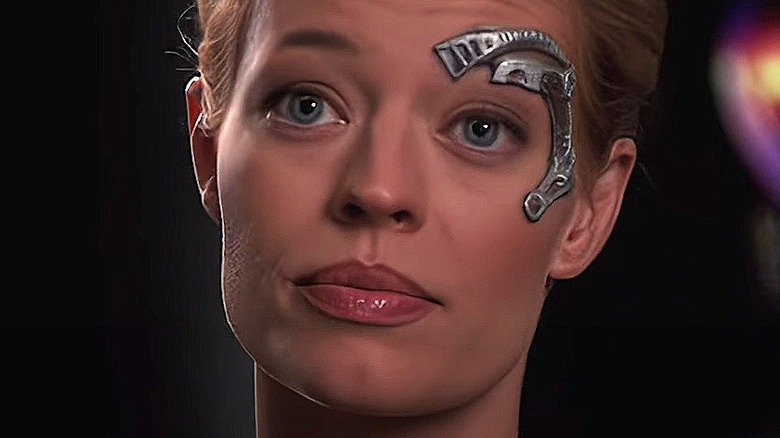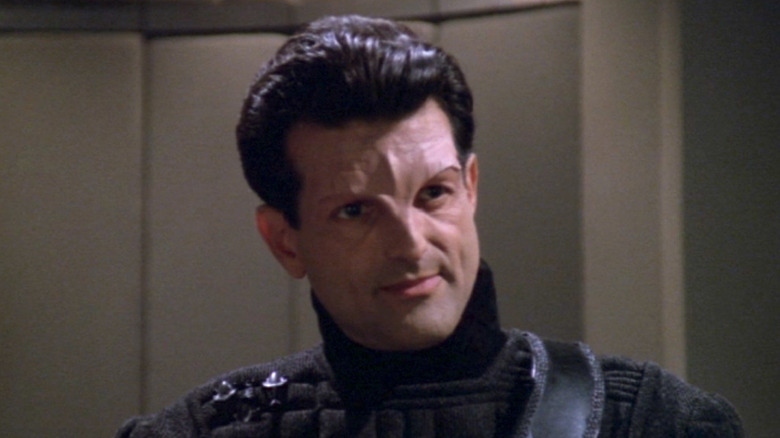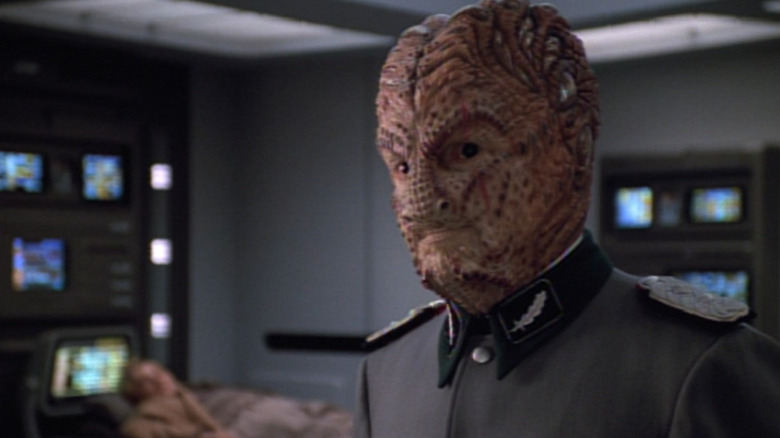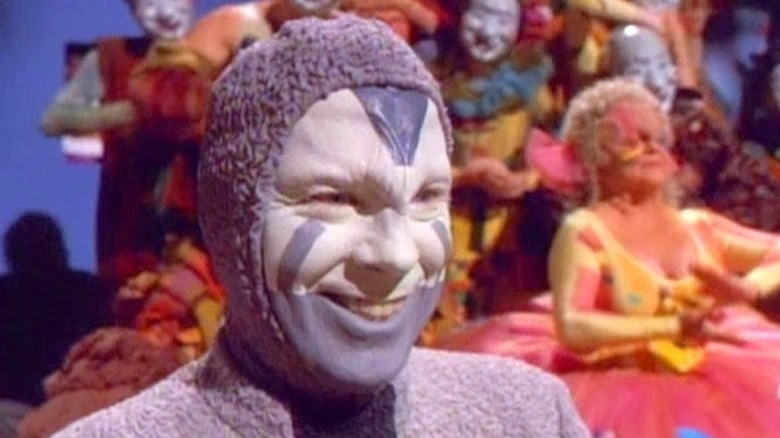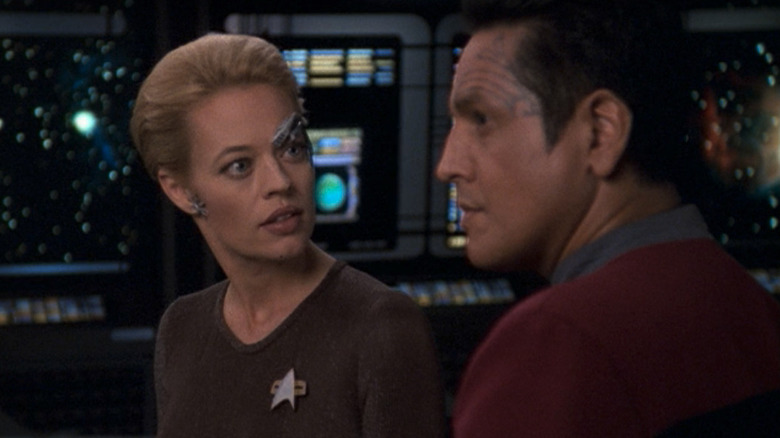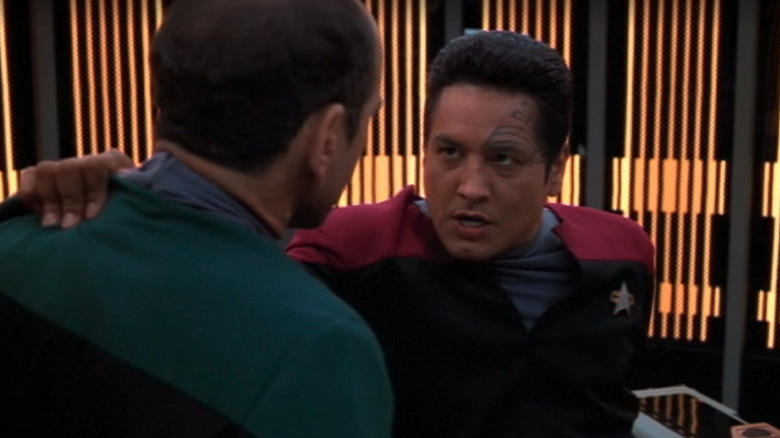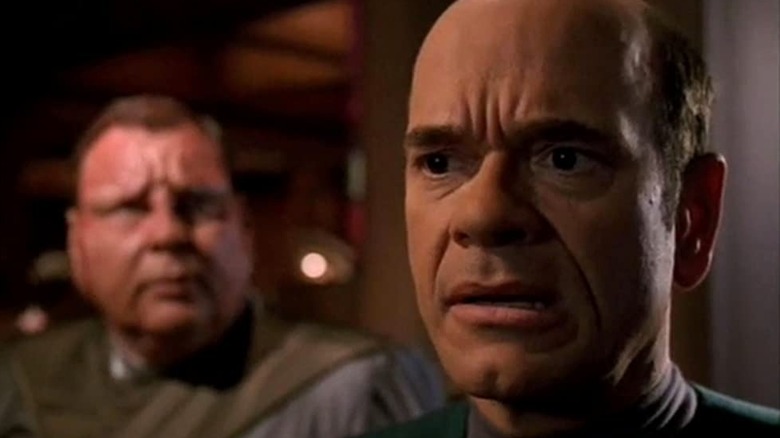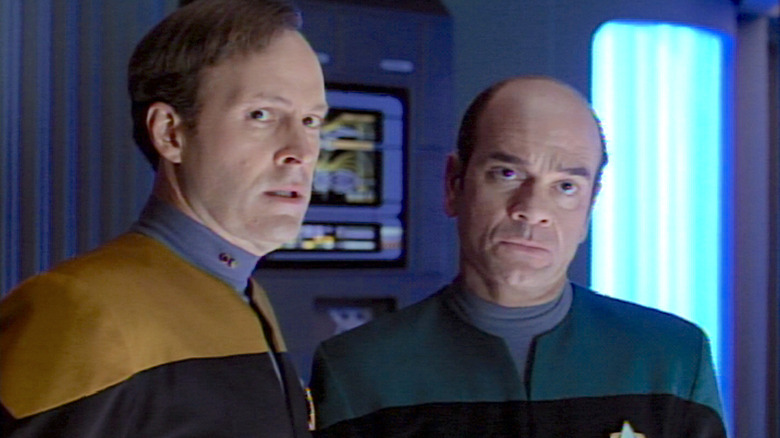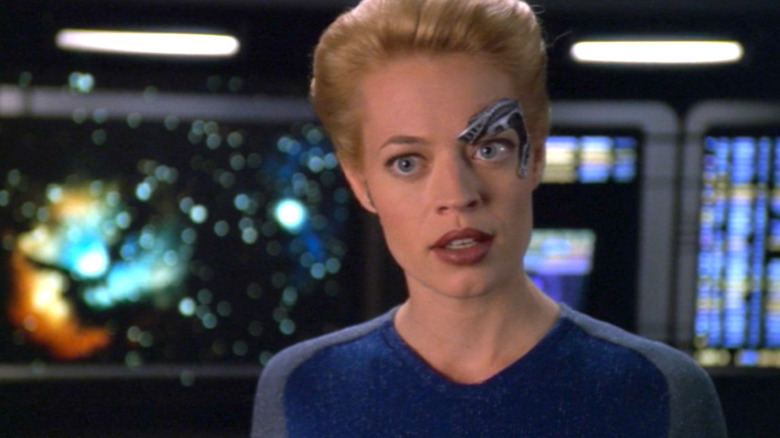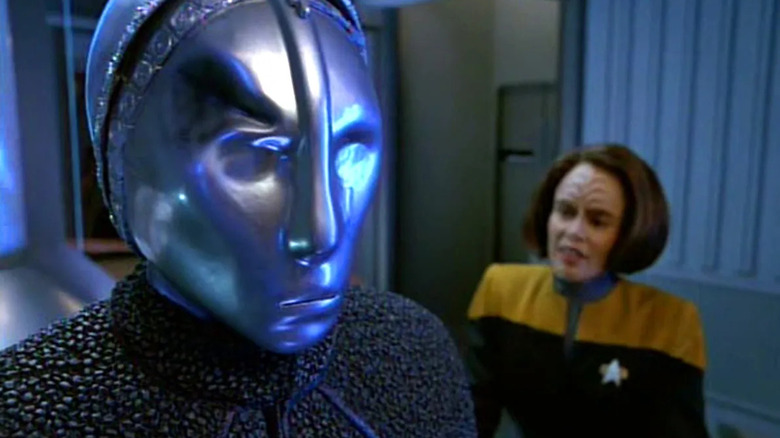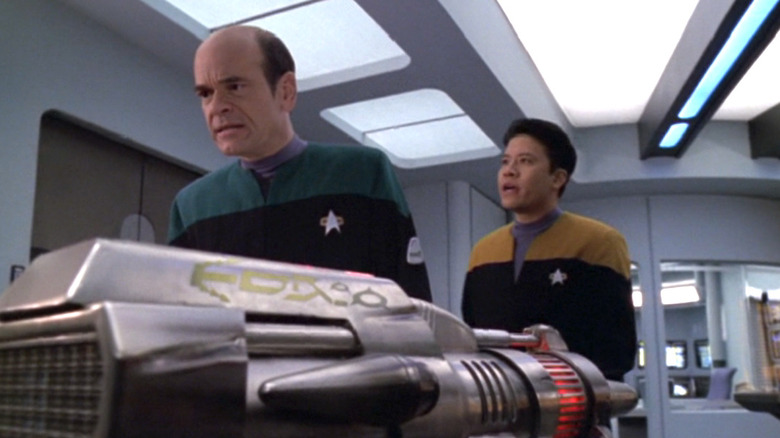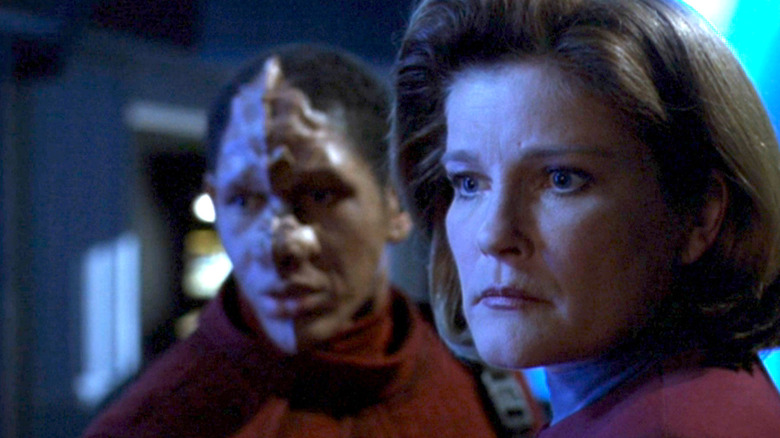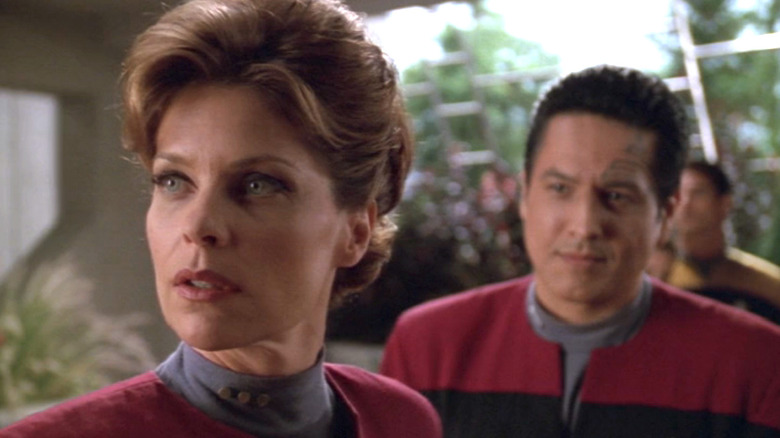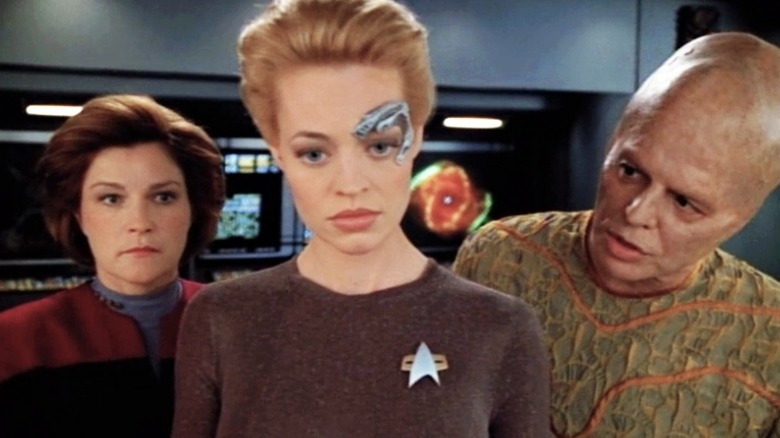The Most Underrated Episodes Of Star Trek: Voyager
"Star Trek" producers took the franchise in a new direction with "Voyager," which began its seven-season run in 1995. The series set out to explore some strange new worlds with an all-new crew aboard a starship trapped in the far-flung Delta Quadrant. Led by Kate Mulgrew's Captain Janeway, the crew's ultimate goal is to get back home. The series charted a course for Earth and never looked back.
While "Voyager" didn't produce many of the franchise's overall best installments, it may well be the most consistent "Star Trek" series of the era, with fewer growing pains than "The Next Generation" and "Deep Space Nine." It aired plenty of standout episodes, while its worst have become downright legendary. But in between there are also a number of great stories that never get the respect they deserve.
From stories about the former Borg Seven of Nine and moral dilemmas for the Doctor to Captain Janeway classics, we've compiled a list of some of these unheralded gems. So purge the bio-neural gel packs and raise temporal shields, these are the most underrated episodes of "Star Trek: Voyager."
Counterpoint (Season 5, Episode 10)
There's no denying that Kate Mulgrew's indomitable performance as Captain Janeway is one of the highlights of "Star Trek: Voyager," and one of her most underrated episodes is Season 5's "Counterpoint." An episode that gives the captain a rare love interest, it does so this time with a dark twist, and even a few surprises. Guest star Mark Harelik boards Voyager as Kashyk, a sinister alien enforcer who becomes beguiled with the intrepid Captain Janeway and soon switches sides.
It begins when the titular ship enters the vast territory of the Devore, who are waging an endless campaign of oppression against any and all telepaths. The Voyager (which is hiding a number of telepathic refugees alongside the likes of Tuvok and Ensign Vorik) is subjected to routine inspections. However, Inspector Kashyk defects and joins Janeway in the search for a wormhole that will spirit them away from Devore space. Though skeptical, Janeway soon finds herself falling for Kashyk, whose motives are at best unclear.
Admittedly, clued-in viewers may see some of the episode's twists and turns coming, but they still manage to satisfy. Harelick is another strong guest star, emerging as both a compelling love interest and a foil to Mulgrew's Janeway. This episode ultimately shows just how strong a strategist the captain really is.
The Killing Game (Season 4, Episodes 18 & 19)
While it might not be the best double-length episode that the series has ever produced — it's hard to top the likes of "Year of Hell" and "Equinox" — "The Killing Game" deserves to be in the discussion. This enthralling two-parter, which aired on a single night, sees the return of the Hirogen and explores a different side to the Predator-like race of hunters.
In the episode, we learn that the Hirogen have taken over Voyager and are using the crew in elaborate war games at the behest of a leader who wants to guide his people to a new way of life through simulated hunts. They've turned most of the ship into one big holodeck and are reenacting World War II, with the Hirogen in the role of the Nazis. Janeway and Tuvok are Parisian resistance fighters, and Seven of Nine is a newly arrived French lounge singer who has joined the underground. With no knowledge of who they really are, the crew must find a way to defeat the Hirogen — disguised as the Third Reich — with only the Doctor and Harry Kim on the outside with any idea of what is really going on.
A loving homage to classic Hollywood war movies, the episode's extra length is used to good effect, with big battle sequences and action that goes from the streets of 1930s Paris to the bowels of a 24th-century starship. It might not be the best big episode, but it's an underrated one that deserves more love.
The Thaw (Season 2, Episode 23)
Season 2 installment "The Thaw" is often poorly reviewed for its goofy story and PG attempt at terror. Some critics felt it simply didn't fit in with the show's galaxy-exploring premise, but what it lacks in classic "Star Trek" tone it makes up for with "The Twilight Zone" levels of chills.
The episode sees Voyager investigating a distress signal, but when the crew arrives at its location, they find something truly strange: A group of colonists in suspended animation. In an attempt to live through an ecological disaster, a number of survivors hooked their minds into a virtual reality simulator to help keep them alive. The computer program that is sustaining them has become self-aware, and when Ensign Kim attempts to enter the simulation to revive them, he discovers the program has taken the form of a terrifying alien clown, with his own bizarre circus. Feeding off the fear of his captives, the sadistic clown (guest star Michael McKean) subjects them to his own brand of psychological torture.
With a villain seemingly inspired by a certain Stephen King classic, the episode is admittedly held back by the show's family-friendly nature. But while it may seem silly on the surface, the episode is a fascinating surrealist story propped up by a strong showing from McKean, and its less-is-more approach still provides plenty of classic creepiness.
The Voyager Conspiracy (Season 6, Episode 9)
Once Jeri Ryan joined the cast of "Voyager" for its fourth season, she quickly became the center of some of its best episodes. But, despite all of the highly rated standouts focusing on Seven of Nine, a few remain sorely underrated, and a prime example of that is the Season 5 story "The Voyager Conspiracy." While it may be hard to convince audiences that long-time characters are secretly sinister villains, the episode still manages to keep us guessing from start to finish.
The story begins with Seven of Nine experimenting with a new way of absorbing data by feeding information directly into her Borg implants from the ship's computer during her regeneration cycle. At the same time, Janeway and Voyager meet with an alien scientist who claims to have developed a new method of stellar travel that could, in theory, allow them to traverse thousands of light years in mere minutes. But as Seven begins integrating the alien's data into her implants with the ship's records, she finds disturbing evidence that suggests some members of the crew may be part of a vast conspiracy that intentionally got them stranded in the Delta Quadrant.
A lesson on the dangers of paranoia and wild conspiracy theories, things spin out of control when she manages to pit Janeway and Chakotay against one another. It may not be the most shocking or action-packed episode, but it's an underrated one that will have you wondering if even the most trusted characters are hiding something.
Waking Moments (Season 4, Episode 13)
"Voyager" pushed the boat out with its ambitious stories and mind-bending plot twists. It took big swings at big ideas, even if the execution left something to be desired. While this penchant for cleverness resulted in classics like "Blink of an Eye," "Living Witness," and "Distant Origin," quite a few others have slipped under the radar, including "Waking Moments," a story about a species that communicates through dreams.
The Voyager crew discovers the terrifying somnambulant species when many among them realize they've been having nightmares about the same being. Using an ancient technique called directed dreaming, Chakotay is able to enter his dreams to confront the alien, who tells him they communicate through dream states and they want Voyager out of their territory. Before they can leave, the ship is taken over by the aliens, who seem inexplicably powerful. Chakotay soon realizes that reality is not what it seems, and he may in fact still be dreaming.
We've all had dreams that we thought were real, and "Waking Moments" plays on that unsettling feeling brilliantly. A Hitchcockian tale with a "Star Trek" twist, it will leave you questioning your own reality.
Critical Care (Season 7, Episode 5)
Nobody saw a bigger and more impactful character arc across the seven seasons of "Star Trek: Voyager" than the Doctor. Starting out as an unsympathetic, robotic, and pre-programmed holographic assistant, the Doctor slowly became a fully formed and well-rounded person, earning the respect of his shipmates as a valued member of the crew. While highly rated episodes like "Tinker, Tenor, Doctor, Spy," and "Latent Image" show the Doctor's growth as a character, one of his most underrated stories that illustrates his strides as a dutiful and compassionate physician is "Critical Care."
Being a program within a holographic system poses a problem for the Doctor in the episode, with his mobile emitter stolen and sold to an alien hospital on a far off world. There, the Doctor finds himself forced into service on a planet where healthcare is rationed by social status and strictly meted out by a computer system called the Allocator. Under the thumb of a tyrannical administrator named Chellick (Larry Drake), the Doctor is horrified to learn that the Allocator will not give him the resources he needs to treat the sick because it has deemed his patients unworthy. As the situation grows more dire, the Doctor is forced to do the unthinkable to save his dying patients.
Set almost entirely away from Voyager, "Critical Care" has the courage to ask if healthcare is a right or a privilege, making a powerful statement on a hot-button political issue.
Projections (Season 2, Episode 3)
Step back five seasons from "Critical Care" and you'll see just how much the character of the Doctor grew over time. A very different physician in the first couple of years, he was far less playful and far more curmudgeonly. In the underrated episode "Projections," we see him contend with something much more disturbing than an alien adversary or classist computer system — the Doctor must deal with the nature of reality itself.
In the show's first crossover with "Star Trek: The Next Generation," the Doctor is activated in sickbay to find the ship under an apparent attack by the Kazon, only to be greeted by Starfleet engineer Reginald Barclay. According to Barclay, the U.S.S. Voyager isn't real, and the Doctor isn't a hologram at all; He's actually Dr. Lewis Zimmerman, a researcher who's been living inside a holodeck recreation of Voyager to test the effects of long-term deep space assignments. A recent radiation surge has messed with Zimmerman's memories and locked the holodeck, and the only way to shut it down is to destroy the ship.
Though the audience won't be easily fooled, the episode still presents many questions and mysteries for us to unravel. If Barclay isn't real, who is he, and who is really pulling the strings? Will the Doctor solve the question of his own existence? A classic "Star Trek" puzzle episode, "Projections" also sees the return of actor Dwight Schultz as Barclay in one of the best "Star Trek" crossovers ever.
Bliss (Season 5, Episode 14)
"Star Trek" is known for venturing into a variety of genres, and in the under-appreciated installment "Bliss," it goes full monster movie in a story about a malevolent space-borne beast that feeds on the ship. It's also another Seven of Nine episode, this time pairing the former Borg drone with young Naomi Wildman (the mixed-species daughter of the human Ensign Samantha Wildman and the Ktarian Greskrendtregk), firmly establishing Seven as a big sister role model.
In the episode, Voyager comes across an apparent wormhole that seems to lead directly to Earth. Though Seven discovers that the anomaly is not what it appears, Janeway and the rest of the crew become oddly obsessed with returning home, ignoring obvious signs of deception. Once inside the galactic gateway, the crew is knocked unconscious, and Seven of Nine makes contact with another vessel piloted by an alien named Qatai (W. Morgan Sheppard). A rogue monster hunter, Qatai has been hunting what he reveals to be an interstellar creature that feeds off starships, inducing telepathic illusions based on their crew's innermost desires that trick them into entering its belly.
Using the crew's quest to get back to Earth, the beast deceives them, with only Seven, Naomi Wildman, and the Doctor immune to it. A satisfying monster story, "Bliss" also explores Seven of Nine's feelings of isolation among the Voyager crew and brings her one step closer to accepting her humanity.
Prototype (Season 2, Episode 13)
Though "Star Trek" has touched on the limits of A.I., as well as the ramifications of advanced computers and synthetic android life, in "Prototype," the series asks what would happen if such an intelligence were dangerous and uncontrollable on a mass scale. The "Star Trek: The Next Generation" episode "The Measure of a Man" pondered the notion of a robot race, but this "Voyager" installment gives us one, and it isn't the reality that Commander Data might have dreamed about.
Discovering a damaged vessel on their course towards Earth, Voyager beams aboard the ship's lone survivor; a malfunctioning android that identifies itself as Automated Unit 3947. Once repaired by B'Elanna, the unit claims he is part of an entire race of artificial people, constructed by the Builders, a race of people who no longer exist. Unable to repair themselves, the Automated Units are dying off, but B'Elanna believes she can give them the means to repair themselves, and even build new Automated Units. When Janeway tells her this would violate the Prime Directive, 3947 kidnaps B'Elanna and forces her to try.
Though B'Elanna finds success, we soon learn that the stakes are much higher than a dying race of robots, as the Automated Units are engaged in an endless war with another army of rival androids. A tense drama, "Prototype" is a fascinating exploration of where A.I. could take us if we're not careful.
Warhead (Season 5, Episode 24)
One of the many criticisms levied at "Star Trek: Voyager" is that it recycles old plots. Such is the case with the Season 5 episode "Warhead," a story that is not dissimilar to "Prototype." But just because an episode shares common themes doesn't mean it isn't great. "Warhead" gives Robert Picardo the chance to flex his acting chops, playing the episode's psychotic villain: A sentient weapon of mass destruction.
Coming upon a distress signal, Voyager diverts to a remote planet and Ensign Kim is put in charge of the away mission. What he discovers is not a ship in trouble, but an undetonated warhead with an apparently self aware computer. When the warhead is brought onboard and B'Elanna attempts to disarm it, the A.I. takes over the Doctor's program and reveals its mission — to strike at its enemy's territory and obliterate an alien world. Held hostage by a sentient bomb, it's up to Ensign Kim to reason with it and convince it to spare millions of lives.
A classic "Star Trek" story about a sinister living computer, "Warhead" is loaded with social commentary about the futility of war. With an important message on top of its thrilling suspense, the episode might also be Kim's finest hour, and it deserves more attention for that alone.
The Void (Season 7, Episode 14)
There have been plenty of seriously political "Star Trek" episodes over the years. One that doesn't get as much attention as it should is the "Star Trek: Voyager" entry "The Void," which tackles the subject of racism in a new way while also offering up an exciting story that sees the crew struggling to live up to Starfleet's highest ideals.
On course through the Delta Quadrant, Voyager finds itself sucked into a bizarre region of space devoid of all stellar matter, a place where lawless marauders attack and steal from each other to survive. As their situation deteriorates, Janeway grapples with whether they too must resort to violence to stay alive before deciding on a bold plan to form an alliance with other ships in this twilight zone. But her principles are tested when the crews she is forced to ally with don't hold to the same code of ethics as Voyager.
At the same time, they discover a race of mute scavengers who are native to the region. Others in the area look down on them as if they were vermin. As the Doctor nurses one of them back to health, he discovers they are bright and inquisitive people who may hold the key to escaping the zone. Full of action and suspense mixed with poignant messages of tolerance and moral integrity, "The Void" is an underrated gem.
In the Flesh (Season 5, Episode 4)
Much was made of the deadly new adversary known as Species 8472 when they were introduced in the Season 5 finale "Scorpion." These all-CGI humanoid aliens defeated the Borg, proving themselves a terrifying new threat. They wouldn't last long, though, and many fans have lamented the fact that "Voyager" almost immediately softened Species 8472 from the most frightening new franchise menace into a potential Federation ally. But what is often overlooked is the episode that did just that, and how compelling a drama it really is.
In the Season 5 episode "In the Flesh," Voyager is stunned to discover an apparent recreation of Starfleet Headquarters at a space station in the Delta Quadrant. Going undercover, Chakotay is confused to find that it's an exact replica, and full of what seem to be Starfleet officers and cadets. But when he makes the shocking discovery that the humans there are actually Species 8472 in disguise, and they are planning a takeover of the Federation, Chakotay is taken prisoner, sparking a tense standoff with Voyager.
Perhaps inspired by Soviet-era recreations of American cities said to have been used to train KGB operatives, "In the Flesh" is a tense, hair-raising affair. Some fans felt that it declawed a compelling villain too soon, but it's still a satisfying story about finding common ground with enemies.
Hope and Fear (Season 4, Episode 26)
"Star Trek: Voyager" Season 4 finale "Hope and Fear" explores the dynamic between the two best characters in the series and serves as the culmination of the season-long tug of war between Captain Janeway and the ship's newest crew member, Seven of Nine. All season long, Seven battled the captain in her attempts to help the former drone adjust to her newfound humanity, never feeling like she fit in alongside the Voyager crew.
In "Hope and Fear," Seven is forced to look her fate in the eye when a visiting alien named Arturis (guest star Ray Wise) finally decodes the garbled message that Voyager received from Starfleet several episodes earlier. In the message, Admiral Hayes tells them that they've parked a new starship, the U.S.S. Dauntless, not far from their location, and with its experimental slipstream engine, it can get them home in mere months. Now, Seven must decide whether to go to Earth where she isn't sure she'll belong, or to stay behind and make a new life for herself in the Delta Quadrant.
Though fans have mostly praised "Hope and Fear" for its emotional climax and sympathetic villain — plus its exciting twists — the episode deserves to be counted among the series' very best. Receiving renewed attention with the debut of a new U.S.S. Dauntless in "Star Trek: Prodigy," this is definitely one episode that critics should revisit.
